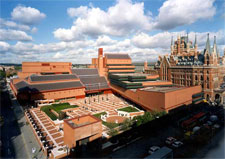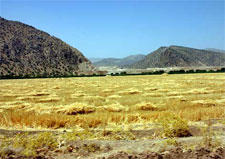|
Collection of Persian Music in British Library
The Sound Archive started its work in 1955 and joined the British library in 1983. Now it holds over a million discs, 185,000 tapes, and many other sound and video recordings. The collections come from all over the world and cover the entire range of recorded sound from music, drama and literature, to oral history and wildlife sounds. They range from cylinders made in the late 19th century to the latest CD, DVD and minidisc recordings. It keeps copies of commercial recordings issued in the United Kingdom, together with selected commercial recordings from overseas, radio broadcasts, and many privately-made recordings. The World and Traditional Music Section has an ongoing program to make good quality sound recordings of live concerts and lectures by visiting musicians and researchers. More than 100 recordings of Iran are being archived in the British library under the same program. Society for Greek and Near Middle Eastern Music, include audio and visual recordings of concerts of Persian, Turkish, and Greek folk, classical, and religious music. The archive includes recordings of Persian classical
and traditional music concerts recorded in London (1987-1988) and
arranged by the West London Iranian Organization. In addition to all of these, the archive has a collection of 20 tapes recorded live in concerts in Iran and Afghanistan in 1969 under a research carried out by Cambridge University, aimed at recording examples of the music of women of Iran and Afghanistan, to make a study of micro-tonal lute fretting, to record music associated with Islamic chivalry, and to record any sounds associated with the qanats (underground irrigation channels in Iran). The archive also includes two tapes of Iranian revolutionary songs composed and released in the beginning days of the Islamic Republic of Iran in 1979. In addition, another collection of Persian music recorded off-air in Iran by ethnomusicologist Ladan Nooshin has been archived in this collection. One of the largest and most diverse collections of the ethnographic music recordings made by a single ethnomusicologist, is recorded by Jean Jenkins from 1969-1985. The collection includes 634 field tapes and 107 example tapes. The collection begins with 16 tapes of music recorded in Central Asia in 1960, and includes one of the most comprehensive surveys of Music of the Islamic World, recorded as Jean Jenkins prepared for an exhibition at the Horniman Museum in 1976. The collection includes music from Saudi Arabia, Afghanistan, Pakistan, Algeria, Morocco, Jordan, Iran, Iraq, Turkey, and Syria. There is another collection of 140 reel tapes, cassettes, and manuscripts, which was supposed primarily to include Turkish music, but later on, recordings from Iran were added to the collection. Bisotun Engineering Astonished ICOMOS
“The Bisotun complex can be considered the museum of engineering and romantic scripts. The five branches of engineering -irrigation, stone crafts, restoration, bridges, and industry, have made Bisotun a site which amazed the representative of ICOMOS,” said Abdol Azim Amir Shahkarami, head of the geophysical studies of the site. “Facing the 2000 year-old architecture of Bisotun and its progressive science and industry, ICOMOS representative was astonished,” he added, “nowadays, one of the main activities that must be regarded is the introduction of the hidden engineering behind the remains of the Iranian ancient monuments and structures. This hidden engineering in Bisotun region indicates that the ancient inhabitants had a proper view of Man, house, bridge, and nature.” The existence of two unique water systems in the complex is a sign of the region inhabitants’ wisdom two thousand years ago. Regarding the location of the site in plain and swampy fields and the usual happening of earthquakes and floods in the region, digging 12 meter deep water channels implies the scientific geological understanding of the inhabitants of the region. The studies reveal that the construction of Khosrow Bridge was the beginning of urbanization in the complex and Gamasyab River was its vital force. This is while the ICOMOS representative has also suggested the registration of the natural landscape of the site along its other features on UNESCO World Heritage. “Previously, only the registration of the historical site was considered,” said Maliheh Mahabadi, director of Bisotun project, “but ICOMOS suggestion includes also the registration of Bisotun nature.” Bisotun complex, located 30 kilometers northeast of Kermanshah, includes a Median temple, Darius the First’s relief and frieze, Seleucid statue of Hercules, and the Sassanid monument of Bisotun. The most important aspect of the complex is the presence of Darius frieze which was the start point of discovering the ancient Persian, Babylonian and Elamite cuneiforms handwritings. Remains of Wine Production Found in Bolaghi Gorge
Bolaghi Gorge located 4 kilometers from the World Heritage Site of Pasargadae of Fars province is thought to be the location of the most ancient road of Persia, the King Road. According to the Iranian head of the joint team of Iranian and Polish experts, Ali Asadi, a sloped pool leading to a canal at one side with remains of potsherds at the end of the canal were discovered, proving that the ancient residents of Bolaghi Gorge produced wine at the site. Similar structures had previously found in other sites including Mamourin Tepe. As Asadi explained, “Residents of the area at the Sassanid era dumped the grapes in the pool, squashed them and collected the juice in wine jars put at the end of the canals.” The pool measures 50x20 centimeters and is made out of cobblestones with a mortar cover which was apparently restored at the time of its use. The discovery can be of great help in understanding the agricultural and horticultural methods of the time and how people earned their living, explained Barbara Kaim, the Polish head of the joint team of archaeologists, adding that despite the fact that no grapevines today exist in the area, the architectural discovery is proof of the existence of trees and wine production at the ancient times. Previously the archaeologists working in the area had discovered large clay pots which they had assumed to be most probably used for keeping the drinks. Experts are planning to carry out further studies to find remains of grape in the soil of the site. The most ancient wine of the world seems to have been found in a 5000-5500 BC vase in Ajjii Tepe in Iran.
|

 British
library has archived invaluable collections of music from different
nations including Iran.
British
library has archived invaluable collections of music from different
nations including Iran. 
 A
sloped pool leading to a canal at one side with remains of potsherds
at the end of the canal were discovered, proving that the ancient
residents of Bolaghi Gorge produced wine at the site.
A
sloped pool leading to a canal at one side with remains of potsherds
at the end of the canal were discovered, proving that the ancient
residents of Bolaghi Gorge produced wine at the site.